
[Please note this article contains affiliate links to tools we pay for and use often at Credo.]
Smart business owners know they don’t function in a vacuum. To stay ahead in today’s digital-focused landscape, it helps to peek under the hood of other websites’ traffic.
Why? To gauge your competition, most notably. You need to understand your competitor’s website traffic; where it comes from, who else they compete with, where they could improve, and anything else you can glean.
It all matters because data matters. Data-driven decisions are what make or break a business. If you ignore the numbers, you’re out to sea without a paddle – drifting and hoping for the best.
Table of Contents
Why You Should Check Competitor’s Traffic
Analyzing other websites is useful for a few reasons, namely:
- Understand your standing in the industry.
- See what is possible for your own website.
- Inform your own digital marketing strategy (do better where competitors lag behind).
- Identify websites that may be useful for referring customers to your site.
While we should never simply copy and paste the digital strategies of our competitors, this knowledge can be useful when applied in the right way.
After making a habit of monitoring your competitors, you will start to identify trends in the marketing strategies used by your competition and by similar businesses in other verticals.
Some you may realize you can borrow and turn into your own, others may not fit your business. The important thing is to know what your competition is doing with their digital strategy.
How to Check Website Traffic of Another Site
In order to check website traffic for a competitor’s website, or any website that you don’t own, you’re going to need access to specific tools.
There are many, but they are absolutely not all the same. Here are 10 excellent options to begin with.
If you are primarily concerned about organic (SEO) and monitoring paid traffic, then we highly recommend Semrush.
This link gets you a 14-day free trial (only available via that link). We’ve been paying users for years and genuinely use this tool every single week.
On the other hand, if you’re looking for a holistic view of all the traffic going to a site (including social media and direct traffic) then we recommend SimilarWeb.
SimilarWeb offers both free and paid options. The enterprise tier (paid version) is not cheap but the free tier is still an exceptionally valuable and powerful tool.
For this post, we will focus on Semrush as it is one of our favorite SEO tools and one that deserves a spot in any business’s digital toolbelt.
[To monitor your own website’s SEO health, check out these nine website auditing and crawling tools.]
Monitor Other Website Traffic with Semrush
Semrush is an SEO-focused tool.
Whether you are doing SEO competitor research, display advertising research, or want to see where your competitors are getting their backlinks, then Semrush has a tool for you.
Once you have a Semrush account, navigate to a link similar to this one:
https://www.semrush.com/info/getcredo.com
Simply swap out “getcredo.com” for the site you want to analyze.
You’ll be dropped on the dashboard, and you’ll find a graph like this:

For this example, let’s examine the powerhouse sports apparel company – Nike. After you land on the domain overview (above), you can then drill down into individual organic keywords for Nike’s website:
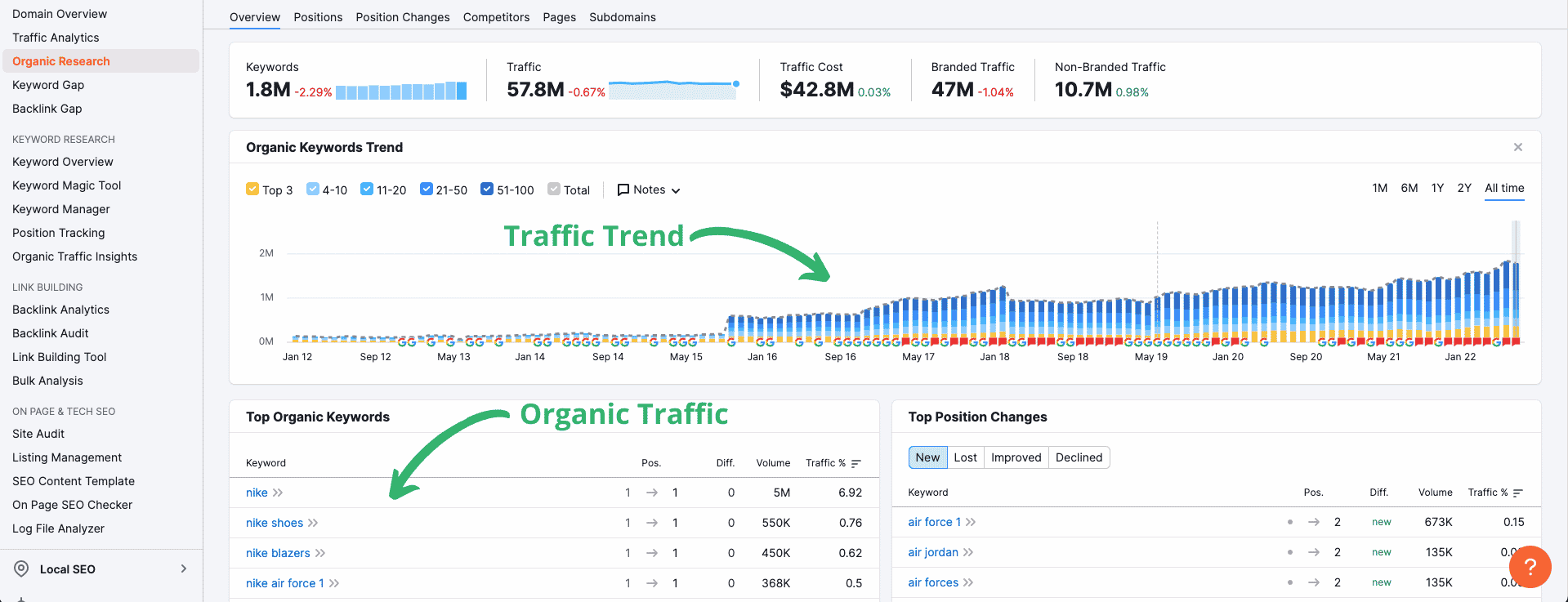
As you scroll down the ‘Organic Research’ page, you will find more valuable insights, such as:
Keywords For Intent
When you want to know a user’s intentions behind a search, all keywords are classified into four main categories of intent: commercial, transactional, informational, and navigational.
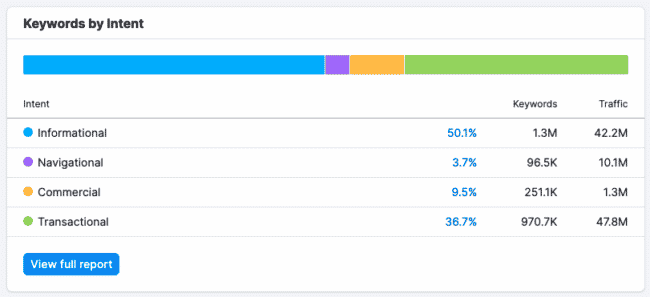
SERP Features
SERP (search engine results page) features are unique elements on a search engine results page that modify the typical format of a search result. Google calls these types of results “search result features” or “search features.”

Here are some of the most common SERP features on Google, according to Semrush:
- Featured Snippet
- Local Pack
- Reviews
- Sitelinks
- Videos
- Top Stories
- Images
- Knowledge Panel
- FAQs
- People Also Ask
- Related Searches
- Google Flights Block
- Hotel Pack
- Job Listings
- Google Ads
- Shopping Ads (Product Listing Ads)
- Rich Snippets
Nike has an array of SERP features in their search results:
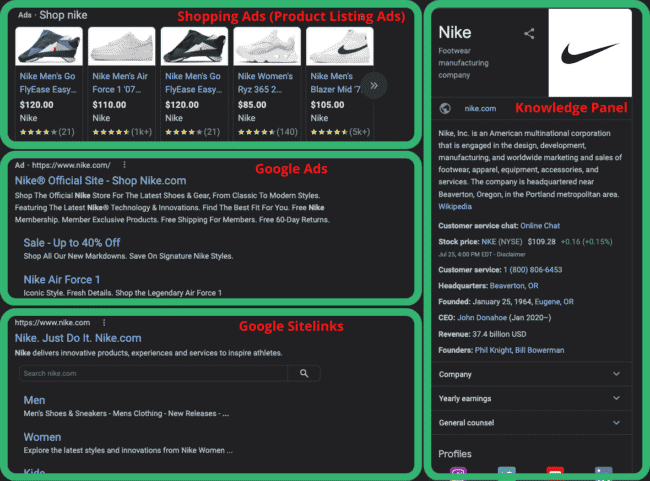
The thing is that SERP features do not automatically show up in search results. They take time to ‘win’.
To be more than just another blue link in a sea of search results, you need to optimize your website’s content to Google’s preferences in order to win these valuable features. And this strategy really does matter – a lot.
In fact, companies that prioritize SEO and content marketing are 13x more likely to generate a positive return on investment.
At a top level, this means that your content is clear, perceived as useful by Google, and organized in a way that Google easily understands. Google awards such websites with a ‘win’ of SERP features.
These features are incredibly beneficial because of the digital real estate it takes up on the SERPs. This is no different than ranking on the first page of SERPs.
The more space your website takes up, the less space your competitors have to work with. Beyond that, it is just easier for customers to find you!
Top Pages
Displays the top pages that fall under the domain. You can see Nike has over 80,000 pages indexed here. They get what we plead you to understand: you need more pages on your website for improved SEO results.
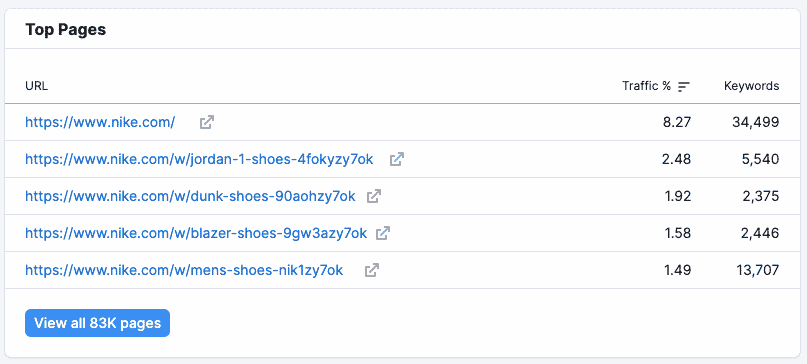
Main Organic Competitors
Nike’s main online competitors, ranked in order by the number of common keywords they share.

Competitive Positioning Map
This map provides a visual representation of where the website stands in relation to competitors. One of the more useful features here is that you can uncover new competitors that you may not have been aware of beforehand.
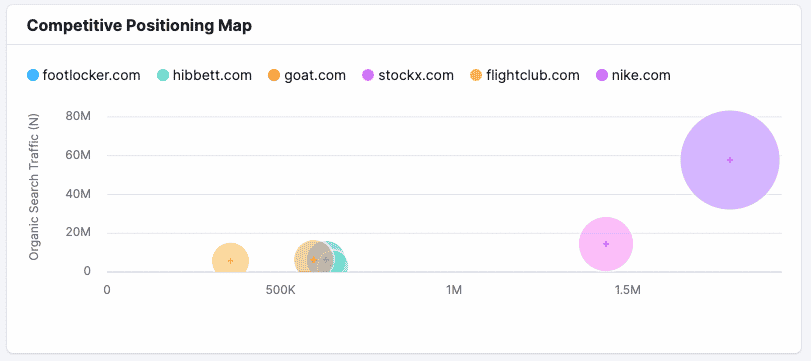
Want a deep(er) dive into the use cases of Semrush? We got you covered.
Check Out The SEMrush Guide
